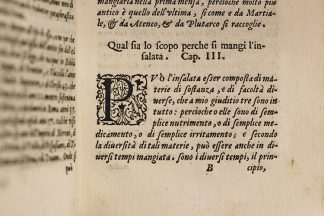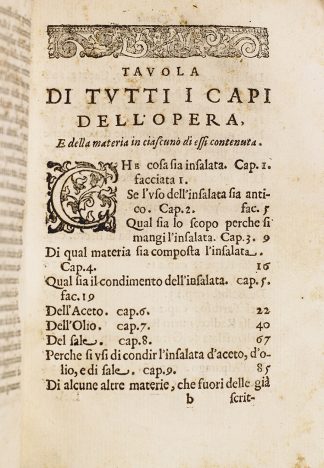Massinio’s 1627 book on salad will be on display at the University of Minnesota Farmers Market outside of the McNamara Alumni Center on September 21 from 11:00 a.m. to 2:00 p.m.
Don’t cry over the last harvest of fresh greens and tomatoes — a new acquisition by the Wangensteen Historical Library of Biology and Medicine will satisfy your love of salads well into the fall.
This 1627 book was written by Salvatore Massonio and Alessandro Maganza. Its title, Archidipno; overe, Dell’insalata, e dell’vso di essa, trattato nuovo, curioso, e non mai più dato in luce, can be roughly translated as “Lettuce and its Uses.”<
Lois Hendrickson, Curator of the Wangensteen Historical Library, shares that this acquisition is notable because it’s the first printed book in the history of gastronomic literature dedicated exclusively to salad.
You are what you eat
Hendrickson describes the book as a “philosophical cookbook for salads.” She notes that Massonio — a humanist, man of letters, physician, and botanist — was ahead of his time, making a connection between salad consumption and good health.
“The classic humoral- Galenic theory was the key to understanding diet and illness, with foods balancing the moist/water and the dry/air, the warm/fire and the cold/earth,” said Hendrickson. “Eating vegetables and fruit was considered dangerous, as they were thought to be responsible for creating putrefaction in the stomach.”
By the end of the Renaissance, however, greens or salad had gained a significant status, and new social and economic elites in the sixteenth century had already begun to consider the consumption of vegetables, and especially greens, as a sign of distinction (1).
Salads and health
Reviewing the content of “Lettuce and its Uses” reveals many treasures, including the following descriptions of salad ingredients, translated from the original Italian by Emily Beck, Ph.D. candidate in the History of Science, Technology, and Medicine. These passages — and others throughout the book — illustrate how Massonio classifies salads as stimulating, nourishing, or therapeutic, and discusses the positive and negative effects of various plants, legumes, shoots, and flowers.
“La cipolla (sia si cotta o cruda) esser materia d’insalata, perche provoca l’appetito del mangiare non meno che del bere.”
The onion (whether cooked or raw) is a salad ingredient because it whets a person’s appetite for eating as much as it does for drinking.
“Il cocomero domestico e molto utile allo stomaco & a corpo: rienfresca quando non si corrompe nello stomaco”
The cucumber is very useful for the stomach and for the body: it refreshes [since] it is not spoiled in the stomach.
What’s inside
Within the book’s 68 chapters, readers will gain access to a wide range of information — all about salads.
“The book includes passages on use of salad in the past, the scope of why we eat salad, and the components with which we make salad,” said Hendrickson. “It even has information on dressings for salad, and other materials that can serve for dressing salad.”
Below are a few snippets from the Table of Contents that serves as a teaser for this first-ever book salads from the 17th century:
- What is salad
- What was the use of salad in the past
- What is the scope of why we eat salad
- What are the components with which we make salad
- What are the dressings for salad
- On vinegar
- On oil
- On garlic
- On the division and the order of the materials of salad
- On parsnip
- On red beets or chard
- On rampion (unrefined wine)
- On sonco (plant of the bellflower family) or barberry
References
- Giannetti, Laura. (2010). Italian Renaissance Food-Fashioning or The Triumph of Greens. California Italian Studies, 1(2). ismrg_cisj_8890. Retrieved from: http://escholarship.org/uc/item/1n97s00d






